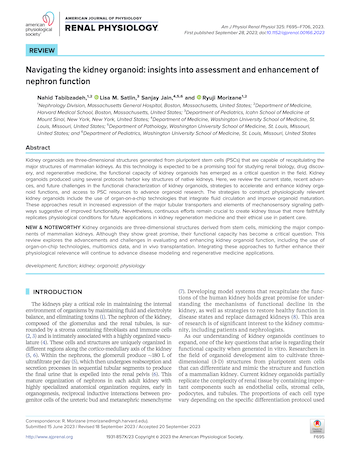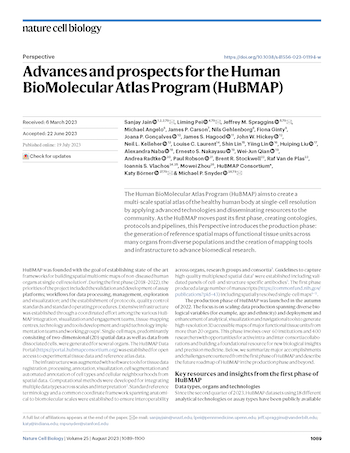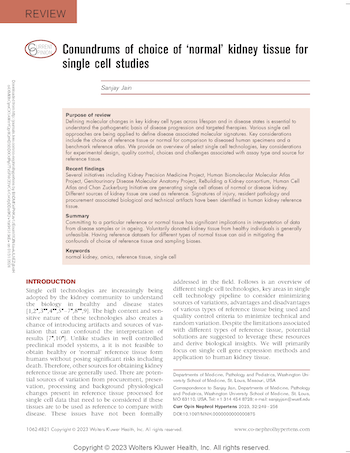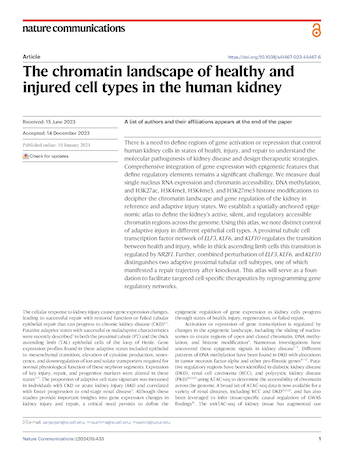Reviews
Navigating the kidney organoid: insights into assessment and enhancement of nephron function
December 1, 2023
Tabibzadeh N, Satlin LM, Jain S, Morizane R. Navigating the kidney organoid: insights into assessment and enhancement of nephron function. Am J Physiol Renal Physiol. 2023 Dec 1;325(6):F695-F706. doi: 10.1152/ajprenal.00166.2023. Epub 2023 Sep 28. PMID: 37767571.
This article describes the state of various organoid culture approaches to derive various nephron segments, functional implications, and iPSC cell lines available for kidney organoid research.
Advances and prospects for the Human BioMolecular Atlas Program (HuBMAP)
August 1, 2023
Jain S, Pei L, Spraggins JM, Angelo M, Carson JP, Gehlenborg N, Ginty F, Gonçalves JP, Hagood JS, Hickey JW, Kelleher NL, Laurent LC, Lin S, Lin Y, Liu H, Naba A, Nakayasu ES, Qian WJ, Radtke A, Robson P, Stockwell BR, Van de Plas R, Vlachos IS, Zhou M; HuBMAP Consortium; Börner K, Snyder MP. Advances and prospects for the Human BioMolecular Atlas Program (HuBMAP). Nat Cell Biol. 2023 Aug;25(8):1089-1100. doi: 10.1038/s41556-023-01194-w. Epub 2023 Jul 19. PMID: 37468756; PMCID: PMC10681365.
This article provides an overview of resources for end to end multiscalar and multidimensional data generation for atlas efforts by the Human Biomolecular Atlas Program (HuBMAP) and provides a roadmap for inter and intraorgan cross talk at single cell, spatial and …
Conundrums of choice of ‘normal’ kidney tissue for single cell studies
May 1, 2023
Jain S. Conundrums of choice of ‘normal’ kidney tissue for single cell studies. Curr Opin Nephrol Hypertens. 2023 May 1;32(3):249-256. doi: 10.1097/MNH.0000000000000875. Epub 2023 Feb 22. PMID: 36811638; PMCID: PMC10073328.
This review discusses quality control and assurance criteria and factors that affect decisions for tissue choice, omics experiments and analytical strategies and advantages and disadvantages of various sources of tissues used for generating healthy reference tissue dataset.
Articles
Deletion of NuRD component Mta2 in nephron progenitor cells causes developmentally programmed FSGS
Preprint: October 20, 2023
Jeannine Basta, Lynn Robbins, Lisa Stout, Michelle Brennan, John Shapiro, Mary Chen, Darcy Denner, Angel Baldan, Nidia Messias, Sethu Madhavan, Samir V. Parikh, Michael Rauchman
bioRxiv 2023.10.18.562984; doi: https://doi.org/10.1101/2023.10.18.562984
This article is a preprint and has not been certified by peer review.
The chromatin landscape of healthy and injured cell types in the human kidney
January 10, 2024
Gisch DL, Brennan M, Lake BB, Basta J, Keller MS, Melo Ferreira R, Akilesh S, Ghag R, Lu C, Cheng YH, Collins KS, Parikh SV, Rovin BH, Robbins L, Stout L, Conklin KY, Diep D, Zhang B, Knoten A, Barwinska D, Asghari M, Sabo AR, Ferkowicz MJ, Sutton TA, Kelly KJ, De Boer IH, Rosas SE, Kiryluk K, Hodgin JB, Alakwaa F, Winfree S, Jefferson N, Türkmen A, Gaut JP, Gehlenborg N, Phillips CL, El-Achkar TM, Dagher PC, Hato T, Zhang K, Himmelfarb J, Kretzler M, Mollah S; Kidney Precision Medicine Project (KPMP); Jain S, Rauchman M, Eadon MT. The chromatin landscape of healthy and injured cell types in the human kidney. Nat Commun. 2024 Jan 10;15(1):433. doi: 10.1038/s41467-023-44467-6. PMID: 38199997; PMCID: PMC10781985.
This study defines regions of gene activation or repression that control human kidney cells in states of health, injury, and repair to understand the molecular pathogenesis of kidney disease. The study measures dual single nucleus RNA expression and chromatin accessibility …



